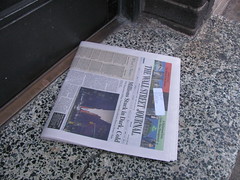
With Halloween right around the corner, University of Minnesota sociology graduate student Meghan Krausch took the opportunity to talk with her students about Halloween costumes that are racist or that perpetuate stereotypes. She was gracious enough to share the activity with us, which is below.
The goal of this lesson plan is to encourage students to consider how Halloween costumes reinforce hurtful stereotypes and white racial dominance in contemporary US society. It also serves a good case study of contemporary debates around race and representation in popular culture.
My course is on US Race Relations, and students were largely familiar with the premise of the discussion already, so I began with the following images and videos. Other courses may need to modify the activity to provide more introduction or basis for the lesson.
I showed a few images of “Indian” costumes, some racial/ethnic costumes for dogs, and a video of a comedy sketch involving blackface from the 1950s. I warned them that the blackface video was very offensive and hurtful, but that I felt it was important for us all to know what “blackface” actually refers to—a specific kind of racist performance that was at one time very common in the US. Examples of such costumes and videos are easy to find on the internet—these are just the ones I happened to use:
http://nativeappropriations.blogspot.com/2011/10/halloween-costume-shopping-sampling-of.html
https://thesocietypages.org/socimages/2009/10/31/can-we-at-least-agree-that-its-racist-to-dress-your-dog-up-like-a-racial-caricature/
http://youtu.be/-p_jxA4p1Wk
I then passed out the following 4 short readings/blog posts on cultural appropriation and Halloween costumes:
http://nativeappropriations.blogspot.com/2011/10/open-letter-to-pocahotties-and-indian.html
http://www.autostraddle.com/im-a-culture-not-a-costume-campaign-stars-halloween-2011-118271/
http://bitchmagazine.org/post/costume-cultural-appropriation
http://www.washingtoncitypaper.com/blogs/sexist/2009/10/28/how-to-inform-a-friend-their-halloween-costume-is-racist/
I asked students to choose one of the readings to read all the way through and to get into groups of 4. The majority of students seemed to find the first reading from Native Appropriations most useful. Based on our class conversation, I would recommend the first two blog posts (the open letter from Native Appropriations and the commentary from Autostraddle), and maybe scratch the other two.
I asked the students to answer the following questions in their groups:
- List at least 3 reasons why dressing up as a member of another racial or ethnic group is hurtful and/or offensive.
- List at least 3 reasons why people continue to wear these costumes.
- Has anyone in the group had any personal experience (with friends or family, for example) with this situation?
- How does the larger social context matter when we think about this issue?
- Design and draw a costume that is not offensive.
We then used this small group discussion to launch us into a larger discussion, which especially focused on dilemmas and debates about how can do what. I focused the students on a few questions, including the role that power, domination, and the larger social context play in determining the difference between when whites dress up as others and when people of color do the same thing.
Finally, I strongly suggest bringing Halloween candy if you are going to discuss Halloween in the classroom!
Meghan Krausch is an instructor and PhD candidate in the Department of Sociology at the University of Minnesota. She is currently finishing her dissertation on utopian social movements and “people’s education” in Buenos Aires. She enjoys exploring the liberatory potential of education in and out of the university classroom.









